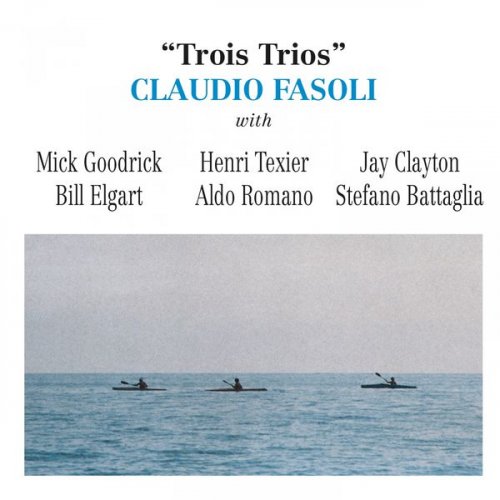
Claudio Fasoli - Trois trios (1999)
BAND/ARTIST: Claudio Fasoli, Mick Goodrick, Henri Texier, Aldo Romano, Bill Elgart, Stefano Battaglia, Jay Clayton
- Title: Trois trios
- Year Of Release: 1999
- Label: Splasc(h) Records
- Genre: Jazz, Contemporary Jazz
- Quality: FLAC (tracks)
- Total Time: 1:06:23
- Total Size: 328 MB
- WebSite: Album Preview
Tracklist:
1. Why (05:10)
2. Sintrio (05:41)
3. Trio (06:31)
4. Crepuscule (07:00)
5. Jambsch (06:26)
6. Why (Part 1, 2, 3) (09:04)
7. Fun (06:23)
8. Triangle (05:41)
9. Why (04:54)
10. Slow Tune (02:33)
11. Sea (Part 1, 2) (06:57)
1. Why (05:10)
2. Sintrio (05:41)
3. Trio (06:31)
4. Crepuscule (07:00)
5. Jambsch (06:26)
6. Why (Part 1, 2, 3) (09:04)
7. Fun (06:23)
8. Triangle (05:41)
9. Why (04:54)
10. Slow Tune (02:33)
11. Sea (Part 1, 2) (06:57)
Vanguard saxophonist Claudio Fasoli is legendary for his obsession with restlessness and tonal intrigue. This album featuring him in not one but three different trios goes a long way to expanding timbral languages for the saxophone family as it engages not only with other instrumentalists, but with the kinds of tonal language that they can explore and evoke when placed in tandem in such a manner. The first trio features Fasoli with bassist Henri Texier and drummer Aldo Romano, and their tunes are more reminiscent of a Manfred Eicher-produced date for ECM. They are fraught with long single-note lines and plenty of bow work from Texier, who iterates his various engagements of timber to the microtonal linguistics of Fasoli. On the second trio with vocalist Jay Clayton and pianist Stefano Battaglia, the effect is more lush, tender, full of nocturnal and pastoral beauty; there is a dialogue between pianist and singer, and singer and saxophonist, and finally with pianist and saxophonist that is established before the trio begins its exploration into the underside of minor-key melodics. Finally the trio, with electric guitarist Mick Goodrick and drummer Billy Elgart, is fraught with shades and colorations of texture and dynamic as the strings and rhythm create an open modal form for the exploration not of melody of inverse or deconstructed harmonics. This is an interesting record, but one that is for all of its virtuosity and restlessness a tad frustrating because of the listener's wish to hear all three of these settings explored more exhaustively.
Review by Thom Jurek
Review by Thom Jurek
As a ISRA.CLOUD's PREMIUM member you will have the following benefits:
- Unlimited high speed downloads
- Download directly without waiting time
- Unlimited parallel downloads
- Support for download accelerators
- No advertising
- Resume broken downloads


